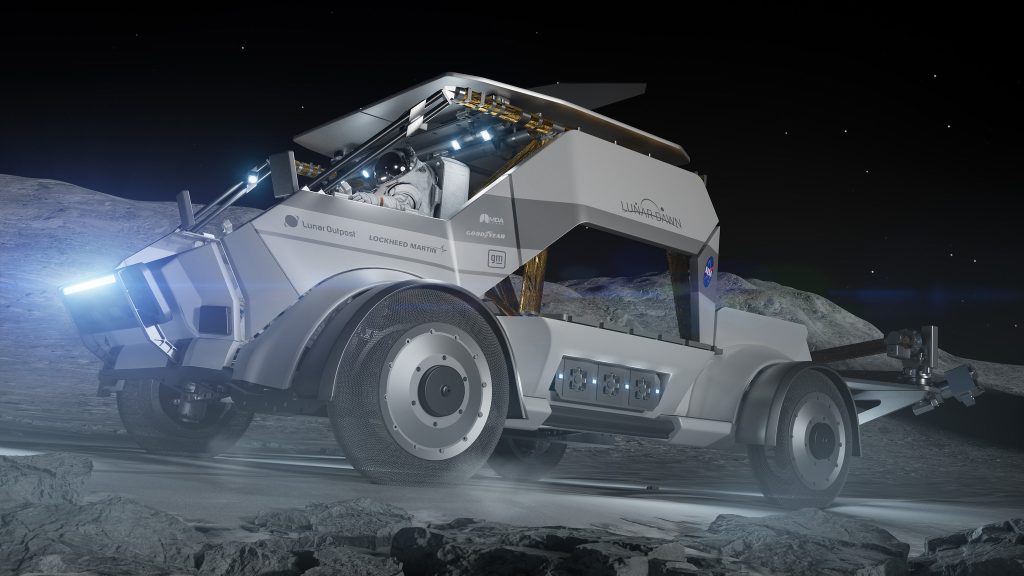CAMBRIDGE, Mass. — NASA has picked three companies to work on ideas for lunar rovers that would be provided for Artemis lunar landings and scientific activities.
On April 3, NASA announced its selection of teams led by Intuitive Machines, Lunar Outpost, and Venturi Astrolab for its Lunar Terrain Vehicle (LTV) Services contract. This contract involves creating and building rovers to be used by astronauts on Artemis missions, beginning with Artemis 5 at the end of the decade. The companies will provide the rovers to NASA as a service, similar to how the agency is acquiring spacesuits and lunar landers.
While the main purpose of the LTV is to transport astronauts on the moon, NASA also plans for the rover to be controlled from a distance, enabling it to conduct scientific investigations when astronauts are not present. “Think of a combination of the Apollo-style lunar rover driven by our astronauts and an unmanned mobile science platform,” explained Vanessa Wyche, director of NASA’s Johnson Space Center, during a briefing about the contract selections.
“The objective is to be able to carry out research with astronauts, transport them, help them access locations they wouldn't be able to reach otherwise, and then continue exploration and science after they have left,” clarified Jacob Bleacher, chief exploration scientist at NASA Headquarters.
Intuitive Machines is leading a team named Moon RACER, or Reusable Autonomous Crewed Exploration Rover, which includes AVL and Michelin from the automotive industry, and Boeing and Northrop Grumman. The lander will be transported using a Nova-D lander that Intuitive Machines is constructing, a larger version of the Nova-C lander that it landed on the moon in February.

Lunar Outpost, a startup currently developing four small robotic rovers, is leading a team named Lunar Dawn that includes Lockheed Martin, MDA Space, General Motors, and Goodyear. While Lockheed and MDA Space will provide expertise in spacecraft design and robotics, GM will offer battery and related automotive technologies, and Goodyear will provide tires.
Venturi Astrolab is offering its FLEX rover, a robotic version of which it plans to send to the moon on a SpaceX Starship mission in late 2026. It is working with Axiom Space and Odyssey Space Research on its LTV award.
Executives from the three winning companies did not disclose many technical details about their rovers, primarily because they still need to refine their design. “There are numerous subsystems that we included in the initial design that will be adjusted” in the next year, stated Steve Altemus, CEO of Intuitive Machines. These subsystems, he noted, range from power to the rover’s suspension system.
Jaret Matthews, CEO of Astrolab, mentioned that the company has built a full-sized terrestrial prototype of its FLEX rover, which has been operated for thousands of hours, including field tests in Death Valley, California. “We’re approaching this with a lot of existing experience with the technologies we plan to apply here,” he said. “We aim to surpass NASA’s requirements.”
Justin Cyrus, the head of Lunar Outpost, mentioned competitive reasons for not providing details about the design, but highlighted the Goodyear tires. He expressed excitement about how the technology used in LTVS can be applied to Earth, and expressed a desire to have those tires for his own offroad vehicle.

Maintaining competition
The overall LTV Services contract has a maximum value of $4.6 billion over 15 years. The three companies have only received small task orders for a "feasibility phase" to advance the rover designs to a preliminary design review over the next year, according to Lara Kearney, manager of NASA’s Extravehicular Activity and Human Surface Mobility Program.
She did not disclose the value of those task orders due to a procurement “blackout” period. However, Intuitive Machines stated in its contract release that its task order was worth $30 million.
After the feasibility studies, NASA will request proposals from the three companies for a “demonstration” task order to support final development of the rover and its delivery to the moon's south polar regions for remote testing before the Artemis 5 mission arrives.
Kearney mentioned that NASA plans to choose only one of the three companies for the demonstration task order and then purchase LTV services annually for crewed and uncrewed rover activities.
NASA, while emphasizing competition in its embrace of commercial services, appears to rely on a single company for the LTV, contrary to its approach for cargo and crew transportation to the International Space Station and the Human Landing Services program.
Kearney stated that NASA's current approach is based on available budgets, but hinted at possible future competition opportunities. She described the contract mechanism as highly flexible, allowing for more task awards and the inclusion of new providers through an on-ramp clause.
NASA did not reveal the number of LTV proposals it received due to a procurement blackout. However, information in a federal procurement database indicates that the agency received nine proposals, without specifying the unsuccessful bidders.
One company that expressed interest in the LTV competition but was not chosen was Leidos, which presented a prototype of its rover design almost a year ago, in collaboration with automotive and aerospace companies. Another partner was NASCAR, which Leidos enlisted for technical expertise and experience in corporate sponsorships.
A company developing an LTV rover for NASA will also be able to offer it to non-NASA customers. “We believe that NASA will have to be somewhat of an anchor tenant in the early stages,” Kearney said. “We hope that, over the 10-year operating life of this vehicle, we can start attracting more commercial requests as the market evolves.”
The speaker mentioned that NASA plans to initially use 75% of the rover's ability for crewed or robotic tasks, and the remaining 25% can be used for commercial purposes. NASA expects that its portion of rover usage will decrease as more commercial requests come in over time.
Bleacher expressed his excitement to see how LTV could help with lunar science, whether by assisting astronauts or through robot operations. He said, “I like to think about the sights and the views that the LTV will allow us to see from the moon's surface. Its mobility will significantly alter our perspective of the moon.”









